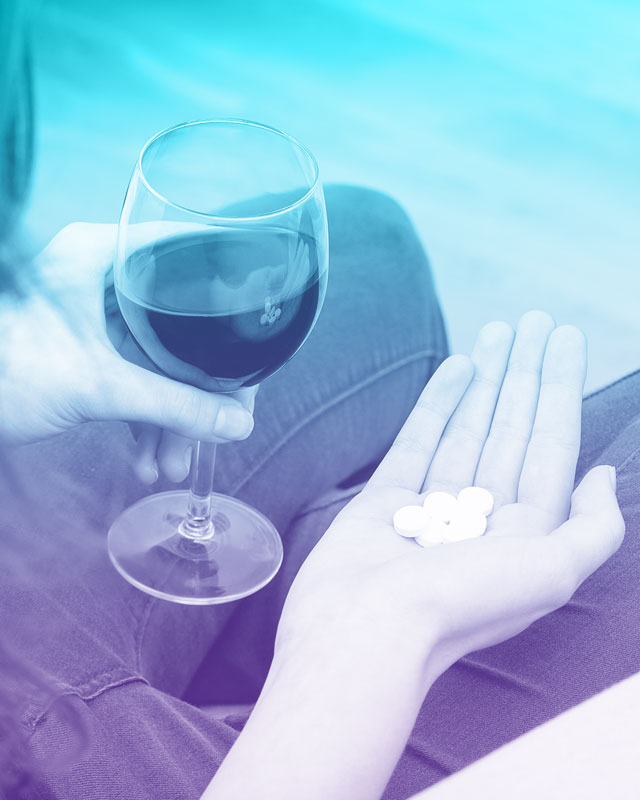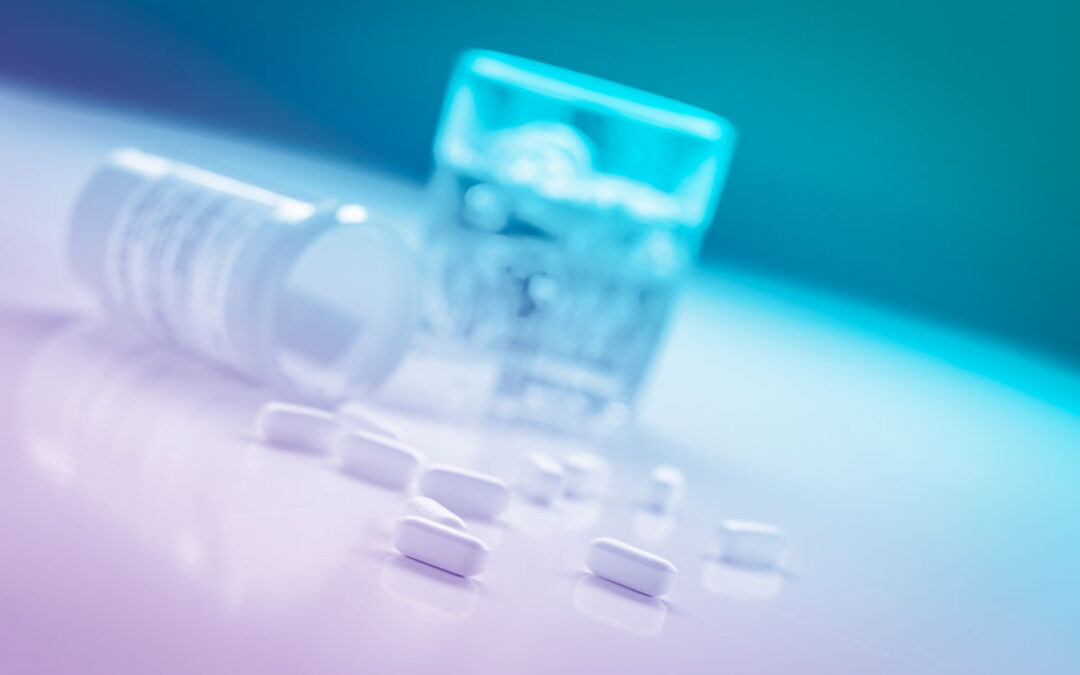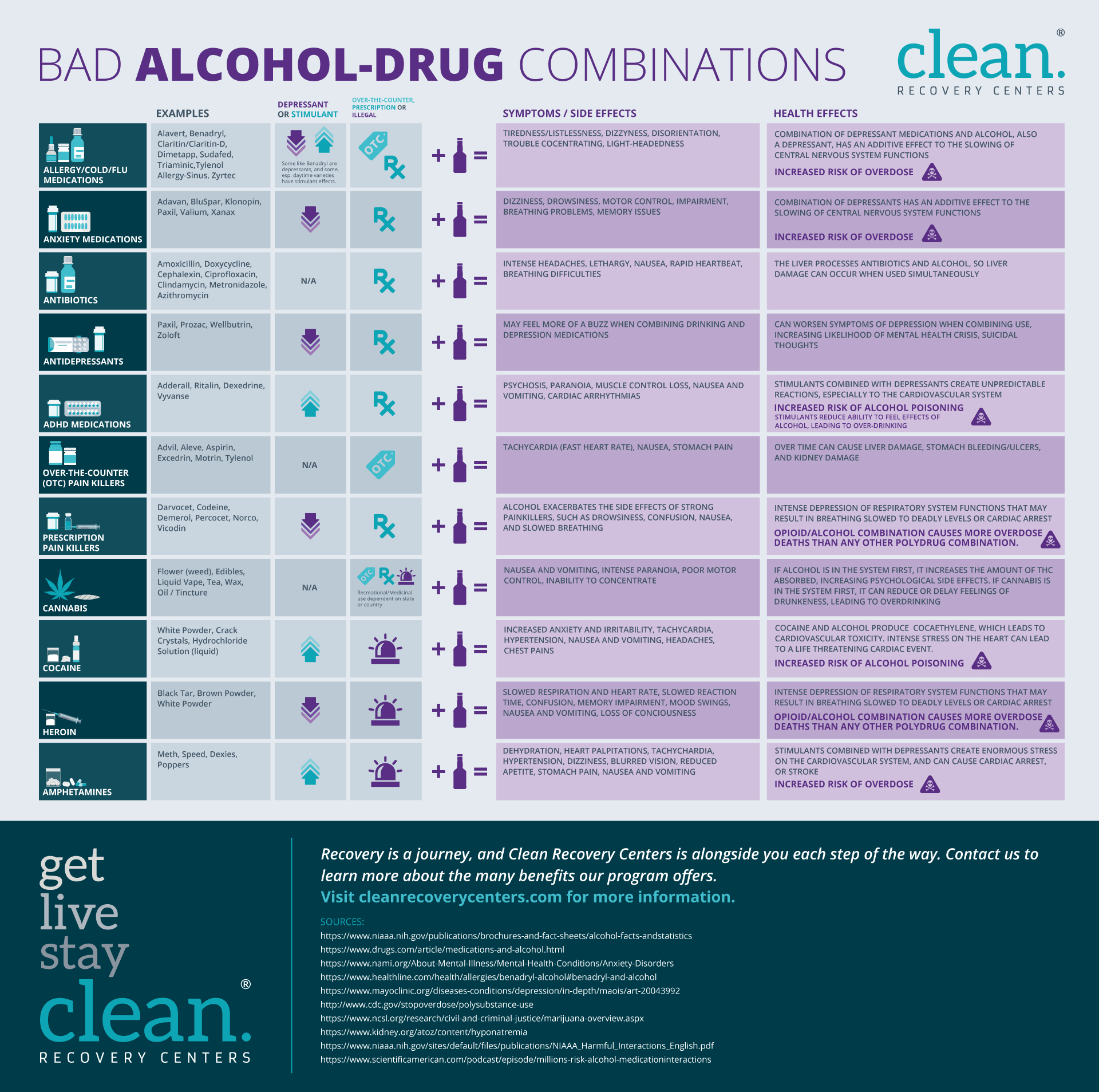Bad Alcohol Drug Combinations
For years, pharmaceutical companies have added warnings on medication labels about the dangers of mixing drugs with alcohol. The possible harmful effects of the combinations of drugs and drinking are many, but people often disregard the information, thinking they know how much is safe to consume or don’t understand the risks being taken. According to the National Institute on Alcohol Abuse and Alcoholism, 14.5 million Americans have an alcohol use disorder, and 25.8% binge drink. Many of these people use prescriptions and over-the-counter medications that could lead to serious or deadly interactions.

Additionally, numerous adults and youth use illicit drugs and purposefully mix alcohol to give them a more intense high. There could be any number of substances in illicit drugs that the user is unaware of that could have immediate and potentially lethal side effects when alcohol is included. The problem resides in the fact that body chemistry, health status, age, weight, use patterns, and amounts are only some of the many factors that put you at risk of an overdose or critical health event when you mix substances.
What Are Some Important Things To Know About Mixing Alcohol With Drugs?
Medications are typically safe for users when used as directed, but there are chances of side effects. However, adding alcohol to any medicine poses a bad reaction danger. The depressant effects of alcoholic beverages can be harmful when blended with various active and inactive ingredients in drugs. For instance, some cold and cough medicines and laxatives already have alcohol as an inactive ingredient. The effects of poor interactions can range from mild symptoms to dangerous toxicity.
You could experience drowsiness, nausea and vomiting and headaches. Some individuals can feel faint or lose coordination or ambulation. Severe interactions may prompt breathing difficulties, heart problems, and internal issues. What begins as a mildly symptomatic condition may quickly develop into a deeper medical crisis. If you cannot recognize what is happening or are alone at the time, the consequence could be devastating.
Hypoxia can occur when insufficient oxygen reaches the brain, leading to long-term disability, brain death, or loss of life. You may go into cardiac arrest or have critical internal bleeding. It is impossible to know each person’s risk level until an emergency arises. However, known interactions between drugs and alcohol occur regularly enough to establish identifiable risk patterns.
What Are Serious Drug and Alcohol Combinations?
All drugs have the potential for detrimental interactions when combined with alcohol. Whether prescription or OTC medications, illicit drugs, or herbal remedies, you risk significant harm when combining these substances. These medications or drug groups should never be mixed with alcohol.
Allergy/Colds/Flu
Many people take allergy medications routinely throughout all seasons of the year. These are common medications used to treat allergies, sinus problems, colds and flus.
- Alavert
- Benadryl
- Claritin and Claritin-D
- Dimetapp
- Sudafed
- Triaminic
- Tylenol Allergy Sinus
- Zyrtec
The risks related to these common allergy medications when used along with alcohol are surprising and concerning. People often feel tired, listless and dizzy. You also have an increased risk of overdose. Benadryl and alcohol are both depressants, so the combination severely affects your central nervous system, causing sedation and slowing critical CNS functions within the brain.
Anxiety
Anxiety medications are some of the most widely prescribed medications in the United States. The National Alliance on Mental Health reports that 19.1% (over 40 million) Americans have an anxiety disorder. Unfortunately, individuals receiving treatment often mix alcohol with prescribed medications to alleviate anxious feelings. These are medications routinely used for anxiety that should not be mixed with alcohol:
- Ativan
- BuSpar
- Klonopin
- Paxil
- Valium
- Xanax
The side effects include dizziness, drowsiness, motor control impairment, breathing problems, and memory issues. Due to the formulations in these medications, the risk of overdose from mixing is significant.
Antibiotics
Warning labels on antibiotics provide clear information about the reasons for not mixing with alcohol. The liver processes antibiotics and alcohol, so damage can occur when used simultaneously. Consuming alcohol while on antibiotics causes intense headaches, lethargy, nausea, rapid heartbeat, and breathing difficulties.
Many people don’t realize the potential for a bad interaction. Most individuals who have reactions from combining antibiotics and alcohol are not doing it intentionally. Unfortunately, if you have alcohol use disorder, you are at risk of serious unintended consequences. It is essential to read warning labels to learn potential side effects, like the fact that alcohol also reduces the effectiveness of antibiotics.
Antidepressants
Antidepressants, such as Paxil, Prozac, Wellbutrin and Zoloft, can elevate the effects of alcohol. You may feel more of a buzz when you combine drinking and depression medications. How alcohol affects emotional responses and inhibits what antidepressants are designed to treat is worrisome. People often become deeply depressed and hopeless, leading to a mental health crisis.
Another side effect of some depression medications and alcohol is equally concerning. Individuals who take monoamine oxidase inhibitors, such as phenelzine and tranylcypromine, could suffer serious heart risks if alcohol is consumed with these drugs. Tyramine is a byproduct in red wine and beer that, combined with MAOIs, may cause blood pressure to rise to dangerously high levels.
Attention Deficit and Hyperactivity Disorder
ADHD drugs are CNS stimulants used to help people focus and concentrate. These are the primary types:
- Adderall
- Ritalin
- Dexedrine
Adderall can mask the intoxication level produced by alcohol consumption. Simply put, you may not realize how drunk you are and engage in risky behaviors, including alcohol binging. Stimulants combined with depressants create unpredictable reactions. You may experience psychosis or paranoia, muscle control loss, nausea and vomiting, and cardiac arrhythmias. Counterfeit Adderall is popular and sold as a street drug. It may have unknown ingredients that present an even greater risk when used while drinking.
Painkillers
Doctors recommend or prescribe different medications for pain relief, depending on the severity of symptoms. For minor pain, these OTC medications are often recommended:
- Advil
- Aleve
- Aspirin
- Motrin
- Tylenol
These meds taken with alcohol can trigger tachycardia (fast heart rate), and, over time cause liver damage as well as stomach injury from bleeding and ulcers. Additionally, these strong pain drugs are prescribed for severe pain treatment:
- Codeine
- Darvocet
- Demerol
- Percocet
- Norco
- Vicodin
Mixing prescription painkillers with alcohol has long been understood as a recipe for disaster. These substances together can lead to such an intense depression of respiratory system functions that death may result. Alcohol exacerbates the side effects of painkillers. Recreational drug users are at high risk of reactions because of the amounts of drugs and alcohol taken at one time.
Illicit Drugs
For many people, alcoholism can be the driver of polysubstance use. Individuals who drink are likely to try other substances eventually. Alcohol increases or alters the effects of other drugs and helps people achieve a high that is lost when the body adjusts to the impact of sustained use. Unfortunately, illicit drugs add an entirely different level of danger when it comes to polysubstance use. There is no way to know the ingredients mixed into concoctions created on the black market.
Many illegal prescription pills contain unsafe levels of highly potent substances, such as fentanyl. These drugs alone are extremely hazardous but mixed with alcohol and other drugs often produce a lethal outcome. The Centers for Disease Control and Prevention statistics show that 50% of overdose deaths occur when using multiple drugs. These illicit drugs have detrimental effects on the body if you mix them with alcohol.
Cannabis
Cannabis is gaining ground in many states as a recreational drug and prescription medication for pain management and other conditions. However, it is still a Schedule I illegal substance under federal law. Part of the reason is that research is still taking place as to the effects of cannabis use. Mixing alcohol with any substance is risky, and Cannabis is no different.
People report having spins which lead to nausea and vomiting. However, because marijuana affects the gag reflex, you might be unable to vomit and could asphyxiate as a result. Intense paranoia is another issue caused by mixing these substances, along with poor motor control and inability to concentrate.
Cocaine
Despite the urban legend regarding cocaine and alcohol having a canceling effect on each other, they actually produce a harmful substance called cocaethylene. In high concentrations, this substance leads to cardiovascular toxicity. The heart undergoes intense stress because of the alcohol and cocaine, which can lead to a life-threatening cardiac event.
Heroin
Heroin and alcohol both have depressive effects on the central nervous system. The mixture of these two substances can lead to decreased breathing and heart rate, which can cause loss of consciousness, coma and death.
Ecstasy
Ecstasy (methylenedioxymethamphetamine or MDMA) and alcohol make a well-known toxic mixture. People who use these substances together often lose inhibitions that protect them from acting on dangerous impulses, including the misuse of substances. Ecstasy mixed with alcohol accounts for the most deaths related to the use of this synthetic drug.
Severe dehydration is a significant concern causing users to drink too much water resulting in hyponatremia, a possibly life-threatening reduction in blood sodium levels. These low serum sodium levels also damage kidney functions with consistent abuse of the substances.
LSD (Acid)
LSD users sometimes consume alcohol to help them come down from the drug. The serious side effects of this process include hallucinations, convulsions, irregular heart rate, seizures, breathing problems, and loss of consciousness. The risks far outweigh the reasons to attempt this process.
Mushrooms
“Shrooms” are psychedelics that contain the natural hallucinogenic psilocybin. It is essential to avoid mixing this drug with other substances. Like LSD, mushroom users drink alcohol to induce a comedown from a high. The side effects of nausea and vomiting are bad enough, but alcohol may trigger panic attacks or psychotic episodes.
Amphetamines and Methamphetamines
The problems related to mixing amphetamines and methamphetamines with any other substances are too many to list. These illicit drugs have many unknowns about what they contain and how they are produced. The chemical processes and mixtures could prove deadly without the addition of alcohol. Drinking adds another layer of risk.
While any number of side effects can occur, these drugs put immense stress on the cardiovascular system. The possibility of a fatal overdose runs very high. Alcohol poisoning is another concern, as methamphetamines users may not feel the alcohol effects and continue drinking.
Why Is Mixing Alcohol and Drugs So Dangerous?
This mixture of alcohol and drugs can have immediate and deadly consequences with many different drugs. Your symptoms could range from a crisis event to organ dysfunction or failure over time. Your overall health worsens with long-term, co-occurring substance use. Aside from users who intentionally combine these two substances for the effects of the high, many individuals who consider themselves casual drinkers can have equally serious health problems when alcohol is used with OTC medications and prescriptions.
The issue is so prevalent an NIAAA pamphlet provides a list of medications and the harmful interactions that occur when combined with alcohol. In many cases, the use of alcohol is not so casual and prompts other types of substance abuse. In quick succession, people can get hooked on alcohol and prescription medications and take the leap to different combinations of drugs. Additionally, it is essential to understand that drug mixing of any sort is perilous because of how interactions present in an individual. These are three reasons why combining drugs is a risky personal choice:
- Amplifying: Mixing two drugs can heighten the effects of a high. However, it also boosts the risk of harmful interactions.
- Masking: Drug mixing to alleviate the effects of other drugs masks symptoms that could save your life. You may not realize an overdose or another emergency event is happening when substance combinations hide side effects.
- Unpredictability: The outcomes of mixing legal or illegal drugs with alcohol are unpredictable. There is no way to combine drugs safely or anticipate possible side effects.
It is crucial to your health and well-being to seek help if you find yourself on the slide toward polysubstance misuse or abuse. When substance use takes over, you can experience a decline in all areas of life.
Why Does Timing Matter?
Combining drugs and alcohol is not a game to win. The odds are stacked against you every time you use. Knowing that timing is a factor in triggering crisis situations is important. The more substances you have in your system at one time, the greater the chance of overdose and death. Using alcohol and drugs within a close window of time invites disaster. This is true for illicit drugs and legal medications. Yet, overdose and death still occur without warning. Many factors figure into negative results beyond your control. The one takeaway is you cannot safely mix substances under any circumstances.
How Do You Know If You Have an Alcohol and Drug Problem?
The symptoms of alcohol and drug abuse are not always easily recognizable to individuals. In many situations, substance use disorders are gradual. As time passes, you use more frequently and require more to get the same initial high. It may be challenging to ask for help, and you may not have an adequate social support network to speak with about what is happening. This is a list of questions to ask yourself if you suspect you have a polysubstance abuse issue:
- Do you find yourself craving alcohol and other drugs to the point it overwhelms you?
- Do you feel you could stop using substances without issue?
- Would you rather engage with substances and avoid social settings?
- Do you miss work or other important events due to substance use?
- Do you often think about quitting drinking and drug use?
- Do you have feelings of guilt about your consumption habits?
- Do you forget things after using?
- Does your life feel out of control, and substances help you cope?
Answering “yes” to some or all these questions does not provide an adequate conclusion about the seriousness of your alcohol and drug use issues. It indicates that you may need to have an evaluation and talk with a professional about your concerns. The first step of seeking the help you deserve is the most important one.
Get Treatment and Get Your Life Back
As many as 42% of Americans have been prescribed drugs with the potential for adverse effects in combination with alcohol. People of all ages who mix alcohol and drugs are at risk. While there are many factors that influence the seriousness of reactions, there are no set indicators of who is most likely to have a bad outcome.
At Clean Recovery Centers, our team provides full-spectrum addiction and mental health services you need, along with whole-person programming. We focus on the positives, so you get your life on track physically, emotionally, socially and spiritually. Our evidence-based practices involve stabilization, analysis, treatment and medication management. Treatment objectives are accomplished through a unique three-phase recovery flow: preparation, action and maintenance.
Recovery is a journey, and we are alongside you each step of the way. If you’re interested, we offer an alumni program for continued support once you finish alcoholism treatment. Contact us to learn more about the many benefits our program offers.
Sources:
- https://www.niaaa.nih.gov/alcohols-effects-health/alcohol-topics/alcohol-facts-and-statistics
- https://www.drugs.com/article/medications-and-alcohol.html
- https://www.nami.org/About-Mental-Illness/Mental-Health-Conditions/Anxiety-Disorders
- https://www.healthline.com/health/allergies/benadryl-alcohol#benadryl-and-alcohol
- https://www.mayoclinic.org/diseases-conditions/depression/in-depth/maois/art-20043992
- https://www.cdc.gov/stopoverdose/polysubstance-use
- https://www.ncsl.org/research/civil-and-criminal-justice/marijuana-overview.aspx
- https://www.kidney.org/atoz/content/hyponatremia
- https://www.niaaa.nih.gov/sites/default/files/publications/NIAAA_Harmful_Interactions_English.pdf
- https://www.scientificamerican.com/podcast/episode/millions-risk-alcohol-medication-interactions



